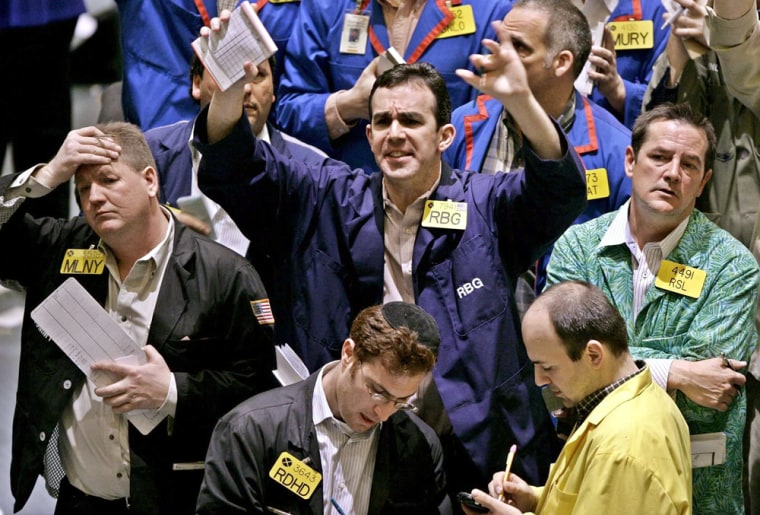Surging oil prices helped send the economy into a nerve-wracking “soft patch” in 2004 and could do it again this year if they rise much higher from current record levels.
The higher cost of energy has caused little economic damage yet despite the pain drivers are feeling at the gas pump, where regular gasoline is selling for an average $2.05 a gallon nationwide — more than $3 in some locations.
But the price of crude oil has already risen 30 percent this year to a record of nearly $58 a barrel, defying the expectations of analysts who expected that oil would settle back into the $40 range after last year’s run-up. If prices remain at current levels or higher, growth could slow substantially in the summer and fall, analysts say.
Oil prices rose slightly Friday to close at $56.72 a barrel in New York trading, within striking distance of the all-time $57.60 record hit Thursday.
“I still expect (energy) prices to moderate,” said Mark Zandi, chief economist for Economy.com, a consulting firm. “But the longer they stay as high as they are, the more damage they will do to the economy. If prices stay where they are even for a couple or three months, growth will be measurably slower than currently expected.”
Rising energy prices create a two-headed monster that attacks the economy both by sucking away discretionary income from consumers and businesses and by pumping up inflation at the wholesale and retail levels.
Zandi and other economists say the higher oil prices could add to the economic pressure created by rising interest rates and a decline in federal tax cuts and spending increases that had helped buoy the economy over the past two years.
Federal Reserve policy-makers, who meet next week, have signaled they intend to continue raising short-term interest rates to keep a lid on inflation, making it difficult for them to respond if rising oil prices begin to undermine growth. The Fed is expected to raise key benchmark rates another quarter-percentage point at their meeting Tuesday, and there is growing speculation they will have to raise rates a half-point sometime this year to stay ahead of the curve on inflation.
So far this year the economy has been growing a bit faster than expected, with retail sales showing surprising strength in the first two months of the year, capital spending by businesses rising at a strong clip and the housing industry continuing to boom.
The latest economic figures are “very, very consistent with the idea that we had really excellent growth last year and now we’re settling down to sustainable, solid, but not great growth,” said Joel Naroff of Naroff Economic Advisors.
That strong growth gives many analysts confidence that the economy will withstand the battering of higher energy prices relatively unscathed.
“The good news is that we went into this period of high oil prices with strong momentum,” said Nariman Behravesh, chief global economist for Global Insight, a consulting firm. “Certainly there is a risk that if oil prices go to $70 a barrel, that could really do some serious damage to growth. It wouldn’t push the economy into recession, but it could trim growth to 2.5 percent.”
For an economy expected to grow at a pace of 3.5 to 4 percent, that would represent a serious slowdown, although the impact would be far smaller than the energy shocks of the 1970s and early ‘80s, when oil hit $90 a barrel in current, inflation-adjusted terms.
But even if oil hit $90 the impact would be smaller than back then because the U.S. economy is far more efficient in terms of energy use than it was a quarter-century ago. Partly because of the shift to a more service-based economy, but also because of federally mandated improvements in energy efficiency, economists figure the U.S. produces about twice as much output per unit of energy as it did 30 years ago.
That means crude oil prices would have to go to $180 a barrel before they would have the impact on the economy they did in the early 1980s, figures Michael Englund, chief economist for Action Economics.

“Oil is still, in fact, a very cheap commodity,” he said.
He said China, which uses far more oil than the United States relative to its gross domestic product, is actually at greater risk of a slowdown caused by oil prices. That is especially true because China pegs its currency to the U.S. dollar, which is the currency used to price oil.
Japan and Europe, by contrast, have been insulated a bit from higher oil prices because their currencies generally have been rising against the U.S. dollar.
For many analysts the latest spike in oil prices is reminiscent of last year, when crude prices rose 20 percent in just a few months, sending the economy into what Fed Chairman Alan Greenspan famously described a “soft patch.”
With the presidential election hanging in the balance, the shaky economy created an anemic 400,000 jobs before settling into growth that most analysts describe as solid but not spectacular.
This time around there is little concern that the economy will drop back into recession, but another slowdown is possible, and a summer of high gas prices seems likely.
“We easily could have big, big spikes in gasoline prices this spring and summer,” said Larry Horwitz, senior economist with Decision Economics. “If it persists it will have a big impact on consumer spending.”
